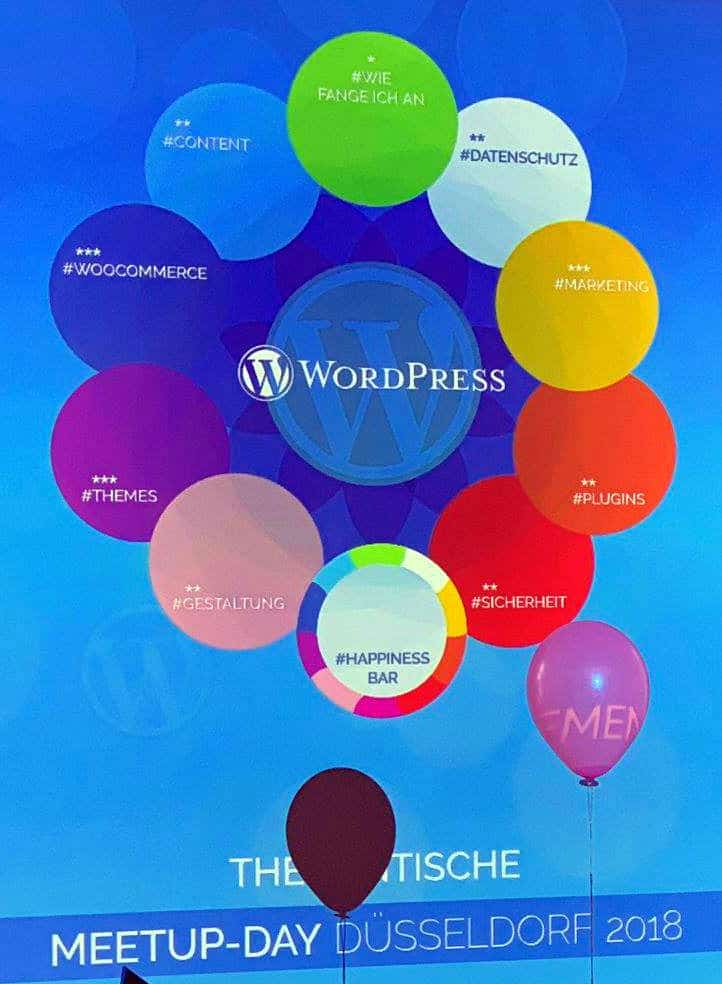
About 100 participants attended our Düsseldorf Meetup Day this time. Like last year, our sponsor was our dear content agency Newcast, which also provided the premises.
About 100 participants attended our Düsseldorf Meetup Day this time. Like last year, our sponsor was our dear content agency Newcast, which also provided the premises.
This year there was a new concept: In the mornings, aslast year, there were two tracks, beginners (A) and advanced (B), in which you could participate at will. Lunch was served around 12 noon and in the afternoon there were ten themed tables where participants could discuss mentored topics with each other.
I had been engaged as a mentor at the table WooCommerce, because I have been looking after various online shops for some time now, including the one of Baby Kochs. This also makes sense because, as a data processing merchant, I am half a merchant and half a data processor with a penchant for data protection officer. My expertise thus covers much of what is needed today for solid eCommerce.

The Morning Tracks
1. The first track
In the first track mainly beginners were given an overview of the Who, How, What of WordPress. It was explained in a total of three short lectures
- Who or what is WordPress and what can you do with it?
- How do we start a WordPress project from scratch?
- What will WordPress bring us next year?
Interesting themes not only for WordPress beginners. But since I can’t be everywhere at once, I decided to join Track B.
2. The second track
The second track was aimed at advanced users and developers because it was about individual development environments and strategies with the topics
- Presentation of the participant workflows
- IDEs, containers like Dockers and similar tools
- Version control and deployment
Yep, that was just right for me, because I’m not satisfied with my WordPress deployment pipeline yet. When changes need to be made to a customer’s installation, this is usually done by mirroring the installation from the production area to a development area (NAS in the office). After programming changes, the updates are then carefully published by hand. This would be done more smoothly by containerization (Docker) or versioning (Git), which I already use anyway, and publishing procedures of revisions by pull (cron job on customer server) or push. This makes sense, at least for larger projects.
The Afternoon Tables
In the afternoon we started with the practical implementation. Conceptually daring and only feasible with plenty of space and expert personnel.
ten tables thou should be on different topics that thou were, for that every undertaking can be discussed.
We mentors occupied our tables on the different topics in order to offer the participants contact points for their specific interests. The tables were marked with different colored balloons depending on the topic.

Every 30 minutes a gong sounded, reminding the participants that there were other tables as well. This brought movement to the constellations. At our WooCommerce table, which I was supervising with Manja from Kandatsu, it was not too crowded. This gave us the opportunity to discuss special topics in detail. For example, the question of separate prices for individual customers at product level kept us busy for some time. The Userspecific Pricing Plugin is available for this purpose, but of course one should not underestimate the effort that individual prices of 200 products would take for 50 customers. That would already be 10,000 individual product/customer combinations, which one should consider.

Later, I had the opportunity to discuss the use of Docker with Peter, as he already had a lot of experience with deployment pipelines.
I had expected a lot from the idea of making changes to customer projects directly in the container and then throwing them into the production environment. Unfortunately, Containerization is not the universal panacea either. I’m not amused, obviously 🙂
Conclusion
At the end of the event, one mentor per table reported on his experiences and the outstanding topics at his/her table during the event.
Through this short summary each participant could still profit from the many topics. Even if you hadn’t managed to visit every table. At the beginning I was sceptical whether this format of many tables and topics would not cause too much chaos and confusion. In retrospect, however, I am convinced that the multi-layered and flexible offer meant that every participant could be offered a tailor-made Meetup Day.
As great as it is to be able to adapt the topics and discussions, including the length of stay, exactly to one’s own needs, it is of course also “expensive” in terms of manpower (womanpower too). Sufficient people are needed whose expertise covers all topics and who are willing to sacrifice a Saturday for the event. The fact that we can easily provide these people with our community speaks very much for the quality and cohesion as a group.
Organizers and volunteers have done a great job with the discussion-stimulating mentoring that we had planned. A big THANK YOU to all participants and visitors. I’m already looking forward to next year, and the many evening Meetups in between.









